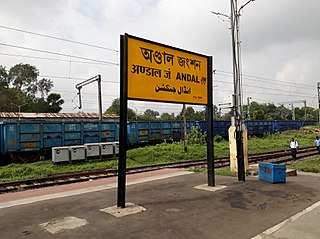Population
As per the 2011 Census of India Ondal CD Block had a total population of 186,915, of which 35,611 were rural and 151,304 were urban. There were 98,149 (53%) males and 88,766 (47%) females. Population below 6 years was 20,893. Scheduled Castes numbered 52,518 (28.10%) and Scheduled Tribes numbered 7,628 (4.08%). [8]
As per 2001 census, Andal block had a total population of 168,807, out of which 91,633 were males and 77,174 were females. Andal block registered a population growth of 9.47 per cent during the 1991-2001 decade. Decadal growth for Bardhaman district was 14.36 per cent. [9] Decadal growth in West Bengal was 17.84 per cent. [10] Scheduled castes at 54,611 formed around one-fourth the population. Scheduled tribes numbered 9,883. [11]
Census Towns in Ondal CD Block are (2011 census figures in brackets): Siduli (8,961), Khandra (15,383), Chak Bankola (part) (1,965), Ukhra (24,104), Mahira (4,188), Dakshin Khanda (8,449), Parashkol (part) (845), Kajora (27,275), Harishpur (8,980), Palashban (4,811), Dignala (13,633), Andal (gram) (6,177), Ondal (19,924) and Baska (6,609). Chak Bankola and Parashkol are partly in Andal CD Block and partly in Pandabeswar CD Block. [8]
Large villages (with 4,000+ population) in Ondal CD Block are (2011 census figures in brackets): Bhadur (4,278), Madanpur (4,631) and Shrirampur (4,235). [8]
Other villages in Ondal CD Block are (2011census figures in brackets): Mukundapur (2,913), Madhusudanpur (3,435), Gaidhoba (2,471), Dhandadihi (3,800), Madhabpur (2,216), Chak Rambati (1,557), Babuisol (1,941), Tamla (732) and Dhubchururia (3,402). [8] (All villages included in 2011 census data are mentioned here. Other villages or localities, if any, are parts of these villages.)













